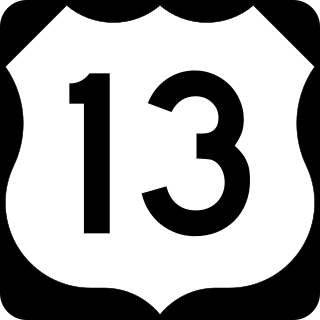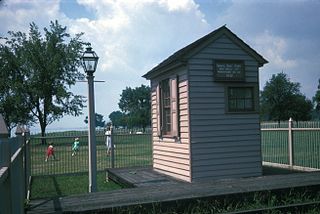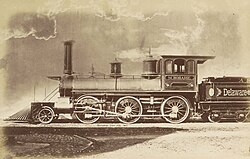
Delaware is a state in the Mid-Atlantic region of the United States. It borders Maryland to its south and west, Pennsylvania to its north, New Jersey to its northeast, and the Atlantic Ocean to its east. The state's name derives from the adjacent Delaware Bay, which in turn was named after Thomas West, 3rd Baron De La Warr, an English nobleman and the Colony of Virginia's first colonial-era governor.

The Delmarva Peninsula, or simply Delmarva, is a large peninsula on the East Coast of the United States, occupied by the vast majority of the state of Delaware and parts of the Eastern Shore of Maryland and Eastern Shore of Virginia.

New Castle is a city in New Castle County, Delaware, United States. The city is located six miles (10 km) south of Wilmington and is situated on the Delaware River. As of 2020, the city's population was 5,551. New Castle constitutes part of the Delaware Valley or Philadelphia metropolitan area.

Delmar is a town in Sussex County, Delaware, United States, on the Maryland border along the Transpeninsular Line. Its motto is "The Little Town Too Big for One State." The population was 1,597 at the 2010 census, an increase of 13.5% over the previous decade. It is part of the Salisbury, Maryland-Delaware Metropolitan Statistical Area and a suburb of Salisbury, MD. When added with Delmar, Maryland, the total population of the town was 4,600 at the 2010 Census.

The Chesapeake & Delaware Canal is a 14-mile (22.5 km)-long, 450-foot (137.2 m)-wide and 35-foot (10.7 m)-deep ship canal that connects the Delaware River with the Chesapeake Bay in the states of Delaware and Maryland in the United States.

U.S. Route 13 or U.S. Highway 13 (US 13) is a north–south United States Numbered Highway established in 1926 that runs for 518 miles (834 km) from Interstate 95 (I-95) just north of Fayetteville, North Carolina, to US 1 in the northeastern suburbs of Philadelphia, Pennsylvania, near Morrisville. In all, it traverses five states in the Atlantic coastal plain region. It follows the Atlantic coast more closely than does the main north–south U.S. Highway of the region, US 1. Due to this, its number is out of place on the general U.S. Highway numbering grid, as it should be running west of US 11 but does not. Its routing is largely rural, the notable exceptions being the Hampton Roads area in Virginia and the northern end of the highway in Delaware and Pennsylvania. It is also notable for being the main thoroughfare for the Delmarva Peninsula and carrying the Chesapeake Bay Bridge–Tunnel to it in Virginia.

The Eastern Shore of Maryland is a part of the U.S. state of Maryland that lies mostly on the east side of the Chesapeake Bay. Nine counties are normally included in the region. The Eastern Shore is part of the larger Delmarva Peninsula that Maryland shares with Delaware and Virginia.

The New Castle and Frenchtown Turnpike and Rail Road (NC&F) was opened in 1831, was the first railroad in Delaware and one of the first in the United States. About half of the route was abandoned in 1859; the rest became part of the Pennsylvania Railroad (PRR) route into the Delmarva Peninsula and is still used by Norfolk Southern Railway. The abandoned segment from Porter, Delaware, to Frenchtown, Maryland, the New Castle and Frenchtown Railroad Right-of-Way, was listed on the National Register of Historic Places in 1976.

The Philadelphia, Wilmington and Baltimore Railroad (PW&B) was an American railroad that operated independently from 1836 to 1881. Headquartered in Philadelphia, it was greatly enlarged in 1838 by the merger of four state-chartered railroads in three Mid-Atlantic states to create a single line between Philadelphia and Baltimore.
Pencader Hundred is an unincorporated subdivision of New Castle County, Delaware. Hundreds were once used as a basis for representation in the Delaware General Assembly, and while their names still appear on all real estate transactions, they presently have no meaningful use or purpose except as a geographical point of reference. It is named after Pencader, Carmarthenshire, Wales.

The Eastern Shore Railroad, Inc. was a Class III short-line railroad that began operations in October 1981 on the 96-mile (154 km) former Virginia and Maryland Railroad line on the Delmarva Peninsula. The line ran between Pocomoke City, Maryland, and Norfolk, Virginia, interchanging with the Norfolk Southern Railway at both ends.

The Maryland and Delaware Railroad Company is a Class III short-line railroad, formed in 1977 to operate several branch lines of the former Penn Central Railroad in both Maryland and Delaware, United States. These branches were omitted from the system plan for Conrail in 1976 and would have been discontinued without state subsidies. As an alternative to the higher cost of subsidizing Conrail as the operator of the branch lines, the Maryland and Delaware governments selected the Maryland and Delaware Railroad Company (MDDE) to serve as the designated operator.
The Shellpot Branch is a former Pennsylvania Railroad/Penn Central through-freight railroad owned and operated by Norfolk Southern since its acquisition, along with CSX Transportation, of Conrail in 1999. The branch allows Norfolk Southern, since the opening of a new bridge in 2001, to bypass the city of Wilmington, Delaware and allows direct access to both the Port of Wilmington and the New Castle Secondary, which connects to the Delmarva Subdivision of the Delmarva Central Railroad that runs to Central Delaware, Maryland, and Virginia's Eastern Shore. Both ends of the branch connect with Amtrak's Northeast Corridor and, like all of the PRR's through-freight lines, was electrified from 1935 until the Conrail era. The line was originally built doubly tracked, but was subsequently converted to single track.

U.S. Route 13 (US 13) is a U.S. highway running from Fayetteville, North Carolina, north to Morrisville, Pennsylvania. In the U.S. state of Delaware, the route runs for 103.33 mi (166.29 km). It traverses the entire north–south length of the state from the Maryland state line in Delmar, Sussex County, north to the Pennsylvania state line in Claymont, New Castle County. US 13 connects many important cities and towns in Delaware, including Seaford, Dover, and Wilmington. The entire length of US 13 in Delaware is a multilane divided highway with the exceptions of the segment through Wilmington and parts of the route in Claymont. Between the Maryland state line and Dover, US 13 serves as one of the main north–south routes across the Delmarva Peninsula. From Dover north to Tybouts Corner, the route is followed by the controlled-access Delaware Route 1 (DE 1) toll road, which crosses the route multiple times and has multiple interchanges with it. US 13 bypasses downtown Wilmington to the east before it heads northeast of the city parallel to Interstate 495 (I-495) and the Delaware River to Claymont. US 13 is the longest numbered highway in the state of Delaware.

Old Baltimore Pike is a road in the U.S. state of Delaware. The road, known as New Castle County Road 26, runs from Maryland Route 281 (MD 281) at the Maryland state line south of Newark, Delaware, and continues east to Christiana, ending near Delaware Route 1 (DE 1). The road is paralleled by Interstate 95 to the north and U.S. Route 40 to the south. The Old Baltimore Pike was built before 1720 and connected Elkton, Maryland, to Christiana. It was a turnpike called the Elk and Christiana Turnpike between 1817 and 1838. In the past it served as a major connection between Philadelphia and Baltimore.

State Road is an unincorporated area in New Castle County, Delaware, United States. State Road is located at the intersection of U.S. Route 13 and U.S. Route 40, southwest of New Castle.
The New York, Philadelphia and Norfolk Railroad was a railroad line that ran down the spine of the Delmarva Peninsula from Delmar, Maryland to Cape Charles, Virginia and then by ferry to Norfolk, Virginia. It became part of the Pennsylvania Railroad system.

The Delaware, Maryland, and Virginia Railroad is a defunct American railroad that operated passenger service from Broad Street Station in Philadelphia, Pennsylvania to Franklin City, Virginia. At the latter city, steamship connections could be made to Chincoteague, Virginia on the Atlantic Ocean-side exterior islands. The railroad was formed in 1883 through a consolidation of the Junction and Breakwater Railroad and the Breakwater and Frankford Railroad. The Philadelphia, Wilmington and Baltimore Railroad took control in March 1891 after the Delaware, Maryland, and Virginia Railroad approached default on two mortgages totaling $600,000. The Delaware General Assembly met with Delaware, Maryland, and Virginia Railroad directors and those of the Philadelphia, Wilmington, and Baltimore Railroad in order to avoid the default and keep the rail lines open. The Delaware, Maryland, and Virginia Railroad shareholders remained minority owners of the line until 1919, when they were unable to meet financial obligations, and the minority shares were sold to the Pennsylvania Railroad.
The Delmarva Central Railroad is an American short-line railroad owned by Carload Express that operates 188 miles (303 km) of track on the Delmarva Peninsula in the states of Delaware, Maryland, and Virginia. The railroad operates lines from Porter, Delaware to Hallwood, Virginia and from Harrington, Delaware to Frankford, Delaware along with several smaller branches. The DCR interchanges with the Norfolk Southern Railway and the Maryland and Delaware Railroad. The railroad was created in 2016 to take over the Norfolk Southern Railway lines on the Delmarva Peninsula. The DCR expanded by taking over part of the Bay Coast Railroad in 2018 and the Delaware Coast Line Railroad in 2019.
The Del-Mar-Va Express was a named passenger train of the Pennsylvania Railroad that at its peak went from New York City to the southernmost point of the Delmarva Peninsula, Cape Charles, Virginia. Initiated in 1926, the train's north–south passage through Delaware stood in contrast with the main passenger traffic through Delaware being a brief passage through cities in the upper reach of Delaware, mainly Wilmington. Most importantly, the train served as a more direct path from New York City and Philadelphia to Norfolk, Virginia, by way of a ferry from Cape Charles across the Chesapeake Bay to Norfolk, a path that bypassed Baltimore and Washington, D.C. This saved time in comparison to travel over PRR, Atlantic Coast Line and Norfolk & Western trains through Washington to Norfolk. The Del-Mar-Va trip, including ferry travel was 11 hours from New York; and the longer all-land route through Washington was 13 hours and 40 minutes.















